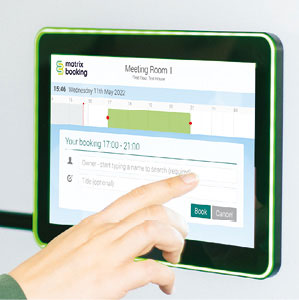LAYING THE GROUNDWORK FOR FUTURE SPACE MANAGEMENT
Many organisations have found that scaling up office attendance without real occupancy data can lead to unintended issues. Recent examples from major global firms illustrate how desk shortages, overcrowding, and logistical friction can arise when office capacity isn’t properly aligned with demand.
JP Morgan, for instance, faced desk shortages at its London headquarters after mandating a full return to the office, leading to overcrowded spaces and employee dissatisfaction. Similarly, Amazon encountered problems in multiple locations where employees were required to be in the office five days a week, only to find there weren’t enough desks or parking spaces available. These cases highlight the risks of enforcing office attendance without a clear, data-driven understanding of how space is being used.
 Although the pilot project was limited to six meeting rooms, its success opened the door to a wider rollout. The company now has the potential to scale this system across the entire building, using the data to make smarter decisions about how office space is used.
Although the pilot project was limited to six meeting rooms, its success opened the door to a wider rollout. The company now has the potential to scale this system across the entire building, using the data to make smarter decisions about how office space is used.
One of the biggest opportunities presented by the data is its role in shaping the company’s approach to hybrid working. By combining occupancy insights with its evolving hybrid policy, the organisation can make more informed decisions about how teams use office space, rather than relying on assumptions or incomplete data.
The insights gained from this project are not only relevant for meeting rooms but can also be applied to other areas of the office. Informal workspaces, collaboration zones, and quiet areas all play an important role in how employees interact with the workplace. Understanding how these spaces are used over time can help facilities teams make smarter layout decisions, ensuring the office meets the needs of employees while maintaining cost efficiency.
THE FUTURE OF DATA-DRIVEN OFFICE MANAGEMENT
The role of workplace data in shaping office strategies is only going to become more critical. As businesses continue to adapt to hybrid work models, real-time occupancy insights provide facilities managers with the ability to make informed decisions about office layouts, resource allocation, and energy efficiency. Instead of relying on static floorplans and outdated assumptions, organisations now can build workplaces that are as dynamic as their workforce.
By contrast, organisations that proactively track and analyse occupancy patterns can make better-informed decisions, ensuring that return-to-office plans are built on real-world data rather than assumptions. The challenges faced by companies with unsuccessful return-to-office mandates serve as a reminder that office capacity planning requires accurate insights, not guesswork.
With sustainability and cost management becoming key priorities for many companies, solutions like Matrix Booking Sense offer a way to achieve both. By reducing unnecessary energy consumption and optimising existing spaces, businesses can create smarter, more sustainable workplaces that evolve in line with employee needs.
This case study highlights how access to real-time occupancy data can fundamentally change the way organisations manage their workspaces. By moving beyond manual counts and assumptions, businesses can gain an accurate understanding of how space is being used.
For facilities managers, the ability to identify underutilised areas, reduce waste, and make informed decisions about office layouts is becoming increasingly valuable. As more organisations look for ways to optimise their workplaces in response to hybrid work models, data-driven solutions provide a practical and scalable way to improve efficiency.
As hybrid work continues to evolve, insights from real-time occupancy data will play an essential role in helping organisations to create environments that are both cost-effective and better suited to employees’ needs.
By focusing on meeting room occupancy now, the company is laying the groundwork for a more intelligent, responsive workplace strategy in the future. The ability to assess how space is truly being used ensures that office design is led by data rather than assumptions, helping businesses adapt to the ever-changing nature of work.






